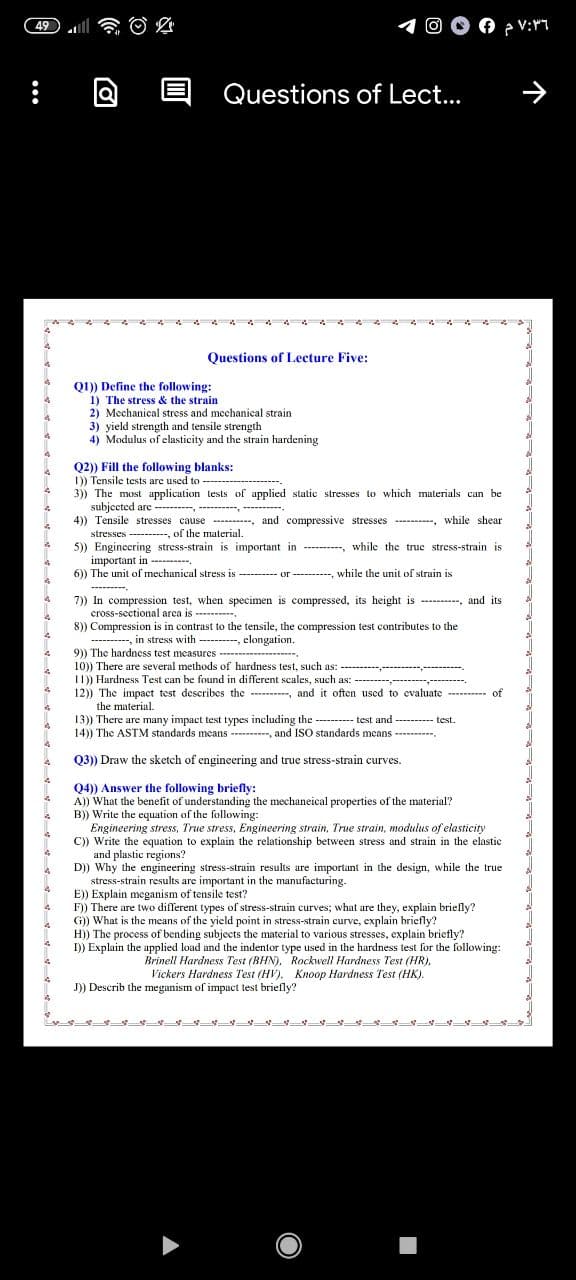Q1) Define the following: 1) The stress & the strain 2) Mechanical stress and mechanical strain 3) yield strength and tensile strength 4) Modulus of elasticity and the strain hardening
Q1) Define the following: 1) The stress & the strain 2) Mechanical stress and mechanical strain 3) yield strength and tensile strength 4) Modulus of elasticity and the strain hardening
Principles of Heat Transfer (Activate Learning with these NEW titles from Engineering!)
8th Edition
ISBN:9781305387102
Author:Kreith, Frank; Manglik, Raj M.
Publisher:Kreith, Frank; Manglik, Raj M.
Chapter5: Analysis Of Convection Heat Transfer
Section: Chapter Questions
Problem 5.2P: 5.2 Evaluate the Prandtl number from the following data: , .
Related questions
Question

Transcribed Image Text:49
Questions of Lect...
Questions of Lecture Five:
01) Define the following:
1) The stress & the strain
2) Mechanical stress and mechanical strain
3) yield strength and tensile strength
4) Modulus of elasticity and the strain hardening
Q2)) Fill the following blanks:
1)) Tensile tests are used to
3)) The must application tests of applied static stresses to which muterials can be
subjected are ---------- ------, --------.
4)) Tensile stresses cause ----------,
stresses -----, of the material.
5)) Engincering stress-strain is important in -----
important in ------.
6)) The unit of mechanical stress is ---------- or ----------, while the unit of strain is
and compressive stresses -----, while shear
---, while the truc stress-strain is
---------.
7)) In compression test, when specimen is compressed, its height is ---------, and its
cross-sectional arca is ------.
8)) Compression is in contrast to the tensile, the compression test contributes to the
---------- in stress with ---------, elongation.
9)) The hardness test measures ---------
10)) There are several methods of hardness test, such as:
11)) Hardness Test can be found in different scales, such as:
12)) The impact test describes the ---------, and it often used to evaluate ------- of
------------------------.
---------------- -
the material.
13)) There are many impact test types including the --------- test and ---------- test.
14)) The ASTM standards means ----------, and ISO standards means ----------.
Q3)) Draw the sketch of engineering and true stress-strain curves.
Q4) Answer the following briefly:
A)) What the benefit of understanding the mechaneical properties of the material?
B)) Write the equation of the following:
Engineering stress, True stress, Engineering strain, True strain, modulus of elasticity
C)) Write the equation to explain the relationship between stress and strain in the elastic
and plastic regions?
D)) Why the engineering stress-strain results are important in the design, while the true
stress-strain results are important in the manufacturing.
E)) Explain meganism of tensile test?
F)) There are two different types of stress-strain curves; what are they, explain briefly?
G)) What is the means of the yield point in stress-strain curve, explain briefly?
H)) The process of bending subjects the material to various stresses, explain briefly?
I)) Explain the applied load and the indentor type used in the hardness test for the following:
Brinell Hardness Test (BHN), Rockwell Hardness Test (HR).
Vickers Hardness Test (HV). Knoop Hardness Test (HK).
J)) Describ the meganism of impact test briefly?
『 -ー一 マー一一一一一一
Expert Solution
This question has been solved!
Explore an expertly crafted, step-by-step solution for a thorough understanding of key concepts.
Step by step
Solved in 3 steps with 2 images

Knowledge Booster
Learn more about
Need a deep-dive on the concept behind this application? Look no further. Learn more about this topic, mechanical-engineering and related others by exploring similar questions and additional content below.Recommended textbooks for you

Principles of Heat Transfer (Activate Learning wi…
Mechanical Engineering
ISBN:
9781305387102
Author:
Kreith, Frank; Manglik, Raj M.
Publisher:
Cengage Learning

Principles of Heat Transfer (Activate Learning wi…
Mechanical Engineering
ISBN:
9781305387102
Author:
Kreith, Frank; Manglik, Raj M.
Publisher:
Cengage Learning